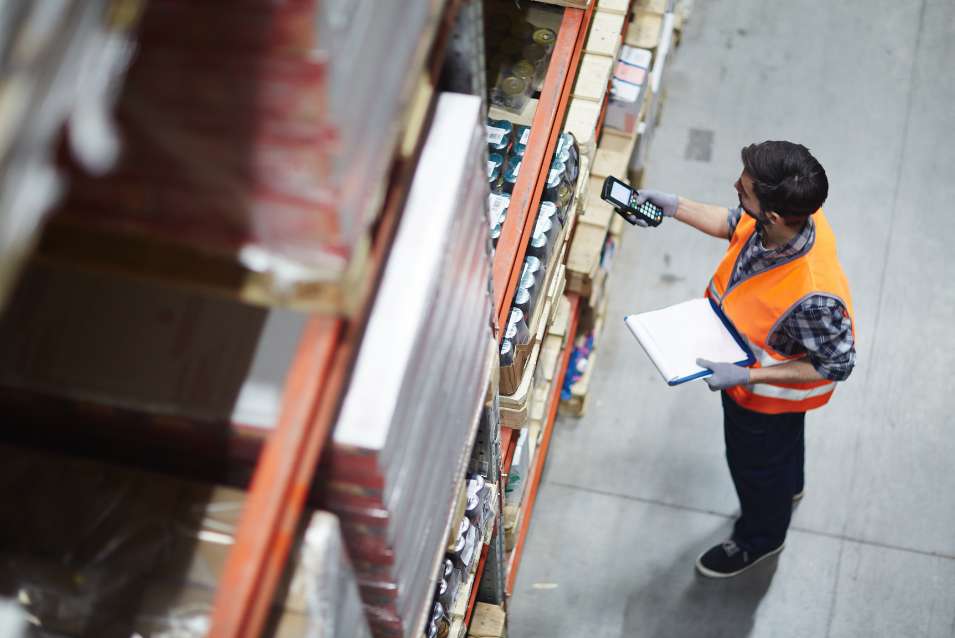Supply chains form the backbone of modern commerce, ensuring products reach consumers efficiently. At the heart of this process lies warehousing, a critical link that has been undergoing a remarkable transformation.
Traditional warehouses faced many challenges, like manual processes and inefficiencies. However, the advent of advanced technologies is reshaping every part of it, offering solutions that boost efficiency and responsiveness. Automation and robotics streamline mundane tasks, reducing human error and accelerating processes. This shift towards technology-driven warehousing in supply chain management marks a pivotal moment, where precision and speed come together to meet the evolving demands of modern supply chains.

Traditional Warehousing Challenges
In the world of supply chain warehousing, traditional approaches encountered several persistent challenges. Their cumulative effect resulted in a less streamlined supply chain, where the flow of products faced many obstacles, such as:
1. Challenges of Manual Processes
Traditional supply chain warehousing heavily relied on manual labor for tasks such as inventory management, order picking, and packaging. This approach often led to inefficiencies, increased processing times, and a higher likelihood of errors in order fulfillment.
2. Lack of Real-time Visibility
Lack of real-time visibility meant that warehouse managers and stakeholders couldn’t access immediate and accurate information about the status and location of inventory. This constraint influenced decision-making, making it challenging to respond swiftly to changes in demand or unexpected disruptions in the supply chain.
3. Difficulty in Tracking and Movement of Goods
In traditional warehousing, tracking the movement of goods within the facility was a complex and often manual process. The absence of automated tracking systems made it difficult to optimize the flow of products, leading to potential delays and inefficiencies in the overall supply chain.
4. Inefficient Flow of Products
Cumulative challenges resulted in an overall inefficiency in the flow of products within the supply chain.
Delays, errors, and lack of real-time insights created bottlenecks, impacting the seamless movement of goods from production to distribution and ultimately to the end consumer.
5. Adaptation to Modern Commerce
The traditional approach struggled to keep pace with the rapidly evolving demands of modern commerce. Increasing customer expectations for quick and accurate deliveries necessitated a shift towards more agile and responsive supply chain warehousing practices.

Advanced Warehousing Technologies
The integration of advanced technologies in supply chain warehouses is reshaping the way goods move through the intricate web of distribution, and there are many options, depending on the specific needs and challenges faced by each supply chain warehouse.
1. Warehouse Management System
A Warehouse Management System is a software solution designed to optimize and orchestrate various aspects of warehouse functions. From inventory management to order fulfillment, a WMS plays a pivotal role in enhancing efficiency and accuracy within supply chain warehouses.
What it does:
- Inventory Tracking and Management: – A WMS provides real-time visibility into inventory levels, enabling precise tracking and management of stock. This minimizes the risk of stockouts or overstock situations.
- Inventory Tracking and Management: – A WMS provides real-time visibility into inventory levels, enabling precise tracking and management of stock. This minimizes the risk of stockouts or overstock situations.
- Order Processing and Fulfillment – Through automated order processing, a WMS ensures accurate and timely fulfillment of customer orders, reducing order processing times and improving customer satisfaction.
- Optimized Warehouse Layout – A WMS helps in organizing warehouse layouts for maximum efficiency. It strategically places products to minimize travel time, enhancing overall warehouse productivity.
- Barcode Scanning and RFID Integration – The integration of barcode scanning and Radio-Frequency Identification (RFID) technology allows for quick and error-free identification of products, reducing manual handling and associated errors.
- Data Analytics and Reporting – A WMS leverages data analytics to generate insightful reports. These reports provide valuable information on warehouse performance, helping stakeholders make informed decisions for continuous improvement.
2. Automated Picking Tools
Automated Picking Tools encompass a range of technologies designed to automate the retrieval of items from warehouse shelves for order fulfillment. These tools minimize the need for manual labor in the picking process, thereby accelerating order processing times.
What They Do:
- Robotics-Assisted Picking – Utilizing robotics, these tools can navigate warehouse aisles, identify specified products, and pick them from shelves with precision.
- Voice-Activated Systems – Voice-activated picking systems guide warehouse personnel through the picking process, reducing errors and increasing efficiency.
- Pick-to-Light Systems – Pick-to-Light systems use visual cues to indicate the location and quantity of items to be picked, streamlining the process and reducing picking errors.
3. Automated guided vehicles (AGVs)
Automated Guided Vehicles are robotic devices equipped with navigation systems that allow them to move autonomously within the warehouse. These vehicles are designed to transport goods, materials, or products from one location to another, optimizing internal logistics.
What They Do:
-
-
- Pick-to-Light Systems – AGVs utilize sensors, cameras, or laser guidance systems for autonomous navigation, ensuring safe and efficient movement within the warehouse environment.
-
-
-
- Material Handling – AGVs are employed for the transportation of goods, pallets, or containers between different warehouse zones, reducing the need for manual handling.
-
-
-
- Task Flexibility – These vehicles can be programmed for various tasks, adapting to the evolving needs of the warehouse, from transporting inventory to supporting order fulfillment processes.
-
4. Automated Inventory Control Platforms
Automated Inventory Control Platforms are advanced systems designed to automate and optimize the monitoring, tracking, and management of inventory within warehouses. These platforms utilize cutting-edge technologies to ensure real-time accuracy and enhance the overall control of stock levels.
What They Do:
- Real-time Inventory Tracking – Automated inventory control platforms employ technologies such as RFID or barcode scanning to enable real-time tracking of each item within the warehouse.
- Demand Forecasting – Utilizing data analytics, these platforms analyze historical data to predict future demand, facilitating proactive inventory management and preventing stockouts or overstock situations.
- Order Optimization – By integrating with order processing systems, these platforms automate order optimization, ensuring that inventory levels align with anticipated demand.
5. Automated Storage and Retrieval Systems (AS/RS)
AS/RS represent a sophisticated class of warehouse automation technology designed to automate the storage and retrieval of goods. These systems utilize a combination of robotics, conveyors, and advanced software to orchestrate the seamless movement of products within the warehouse.
What They Do:
- Automated Storage – AS/RS efficiently store goods in designated locations within the warehouse, utilizing vertical space to maximize storage capacity.
- High-Speed Retrieval – These systems enable swift and accurate retrieval of products, minimizing the time required to access stored items.
- Dynamic Inventory Management – AS/RS integrate with inventory control platforms, ensuring real-time updates and precise tracking of stock levels.
6. Blockchain
Blockchain is a decentralized, distributed ledger technology that provides an immutable and transparent record of transactions. When applied to supply chain warehouse management, it creates a secure and unalterable chain of information, ensuring a single version of truth that all stakeholders can access and trust.
What It Does:
-
-
- Permanent Record Keeping – Blockchain creates a permanent and unchangeable record of each transaction within the supply chain, including the movement of goods within the warehouse.
-
-
-
- Traceability and Transparency – Every step of a product’s journey, from production to distribution and ultimately to the end consumer, is recorded on the blockchain. This ensures transparency and traceability at every stage.
-
-
-
- Smart Contracts – Smart contracts, self-executing contracts with the terms directly written into code, automate processes such as payment upon delivery, reducing the need for intermediaries and streamlining transactions.
-
7. Implementation of the Internet of Things (IoT)
IoT involves embedding sensors, devices, and connectivity into physical objects to collect and exchange data. In the context of supply chain management warehousing, this means creating a network of interconnected devices that provide real-time insights into various aspects of warehouse operations.
What It Does:
-
-
- Real-time Monitoring – IoT devices enable real-time monitoring of critical parameters such as temperature, humidity, and inventory levels, ensuring optimal conditions and precise inventory control.
-
-
-
- Predictive Maintenance – Sensors on machinery and equipment within the warehouse can transmit data to predict potential issues, enabling proactive maintenance and minimizing downtime.
-
-
-
- Asset Tracking – RFID and GPS-enabled devices allow for accurate tracking and tracing of assets, from raw materials to finished products, enhancing overall supply chain visibility.
-
8. Business Intelligence and Predictive Analytics
Business Intelligence involves the gathering, analysis, and presentation of business information, while Predictive Analytics utilizes historical and current data to forecast future trends and outcomes. In the context of supply chain warehousing, this amalgamation of BI and Predictive Analytics serves as a dynamic compass, guiding decision-makers with data-driven precision.
What They Do:
-
-
- Data Integration and Analysis – BI systems collect and integrate data from various sources within the supply chain warehouse, providing a holistic view of operations.
-
-
-
- Real-Time Dashboards – BI tools generate real-time dashboards, offering at-a-glance insights into key performance indicators (KPIs) such as inventory levels, order fulfillment rates, and operational efficiency.
-
-
-
- Predictive Modeling – Predictive Analytics utilizes historical data to create models that forecast future trends, allowing warehouses to anticipate demand fluctuations, optimize inventory levels, and enhance overall operational planning.
-

Benefits of Advanced Warehousing Technologies
Integrating advanced technologies can bring many benefits to a warehouse in supply chain management:
1. Efficient Operations
Automation and advanced tools optimize day-to-day tasks, reducing reliance on manual labor and minimizing errors. This approach boosts overall productivity and creates a more dependable and error-resistant warehouse environment.
2. Enhanced Visibility and Tracking
Real-time monitoring and advanced tracking systems provide unparalleled visibility into warehouse operations, ensuring precise inventory control. The heightened visibility fosters better decision-making as well as empowers warehouses to adapt swiftly to changing demands in the dynamic logistics landscape.
3. Informed Decision-Making
Access to real-time dashboards and predictive analytics empowers decision-makers with comprehensive information, driving operational efficiency by enabling strategic and well-informed choices.
4. Transparent Traceability
Technologies like blockchain enhance traceability and transparency, establishing an accurate record of product journeys within the supply chain. These technologies provide a reliable history of product movement and strengthen trust among stakeholders by providing a clear and tamper-proof view of the entire supply chain process.
5. Space Optimization
Systems maximizing storage capacity through efficient use of vertical space contribute to higher storage density, creating a more resourceful and economically viable warehouse layout.
6. Cost-Effective Operations
Automation, predictive maintenance, and resource optimization lead to cost savings across labor, storage, and operational processes. This strategic approach improves the bottom line and it allows for the allocation of resources to areas that enhance overall warehouse efficiency.
7. Agile Response to Market Dynamics
Advanced technologies empower supply chain warehouses to adapt swiftly to changing market demands, ensuring operational flexibility. Operational flexibility enables warehouses to quickly adjust strategies and resources, aligning with evolving market dynamics for sustained success.
8. Safety in Operations
The risk of accidents is reduced by the deployment of automated guided vehicles (AGVs) and robotics, which contributes to a safer working environment for everyone in a supply chain warehouse.
9. Predictive Planning
Predictive analytics anticipates future trends, facilitating proactive planning and optimized resource allocation. This forward-looking approach prepares warehouses for upcoming challenges and at the same time makes sure that resources are strategically allocated for maximum efficiency.
10. Customer Satisfaction
Real-time tracking, automation, and accurate order fulfillment collectively contribute to elevated customer satisfaction, by ensuring timely and precise delivery experiences that meet and exceed customer expectations.
11. Insightful Analytics
Business Intelligence tools provide comprehensive insights through real-time dashboards and analytics, aiding in strategic decision-making that goes beyond day-to-day operations, helping warehouses chart a course for long-term success. The analytical approach ensures informed choices that align with broader business objectives and market trends.
12. Operational Flexibility
The integration of diverse technologies ensures that supply chain warehouses operate with heightened adaptability, responsiveness, and overall agility, allowing them to swiftly navigate changing conditions and market demands for sustained success in the dynamic logistics landscape.

Disadvantages of Advanced Warehousing Technologies
While advanced technologies bring about numerous benefits to warehouse operations, there are potential disadvantages and challenges associated with their implementation. Some of those disadvantages include
1. High Initial Costs
Implementing advanced technologies often requires significant upfront investments in infrastructure, equipment, and training, which can pose financial challenges for some businesses. These initial costs can create a barrier to entry, particularly for smaller enterprises that may find it daunting to make substantial upfront investments in cutting-edge technologies that promise long-term benefits.
2. Complex Implementation
Integrating new technologies into existing warehouse systems can be complex and time-consuming. It may disrupt current operations and require additional training for the workforce. This complexity extends beyond the physical integration to organizational changes, necessitating a thoughtful and phased approach to implementation to minimize disruptions and ensure a smooth transition for both technology and personnel.
3. Maintenance and Upkeep
Advanced technologies require regular maintenance and updates to ensure optimal performance. Ongoing maintenance costs and the need for skilled technicians can add to the overall expenses. As technology evolves, continuous investments in maintenance become essential to keep systems up to date and operational, emphasizing the importance of a proactive maintenance strategy to avoid unforeseen breakdowns and disruptions.
4. Workforce Adaptation
Employees may face challenges in adapting to new technologies. Training programs are essential, but there can be resistance to change, affecting productivity during the transition period. The success of technology integration heavily relies on the readiness and adaptability of the workforce, highlighting the importance of comprehensive training programs that not only impart technical skills but also foster a positive attitude towards technological advancements.
5. Cybersecurity Risks
With increased connectivity, warehouses become more susceptible to cybersecurity threats. Ensuring robust cybersecurity measures is crucial to safeguard sensitive data and prevent potential breaches. The growing interconnectedness of systems demands heightened vigilance against cyber threats, emphasizing the need for robust cybersecurity protocols and ongoing employee awareness programs to mitigate the risk of data breaches and cyberattacks.
6. Dependency on Technology
Over-reliance on technology may lead to vulnerabilities in case of system failures or technical glitches. Having contingency plans and manual backup processes is essential to prevent disruptions. While technology streamlines operations, acknowledging the potential for system failures underscores the importance of maintaining a balance and having backup strategies in place to ensure continuity of operations during unforeseen technological hiccups.
7. Limited Customization
Some off-the-shelf technologies may have limitations in customization to specific warehouse requirements. This can hinder the ability to tailor solutions to unique operational needs. The one-size-fits-all nature of certain technologies may pose challenges for warehouses with distinct requirements, demanding careful consideration of customization limitations during the selection process.
8. Short Technology Lifecycles
The rapid evolution of technology means that solutions may become obsolete sooner than expected, requiring frequent upgrades to stay competitive. Technological obsolescence becomes a constant concern, prompting warehouses to establish agile technology adoption strategies that can adapt to the fast-paced changes in the tech landscape.
9. Data Overload
Advanced technologies generate vast amounts of data. Without effective analytics and management strategies, this data can become overwhelming and challenging to extract valuable insights from. The abundance of data brings forth the challenge of information overload, underscoring the importance of robust data management and analytics capabilities to derive meaningful insights and avoid drowning in a sea of unprocessed information.

Conclusion
From streamlining operations to enhancing visibility and fostering operational flexibility, these innovations have reshaped how warehouses operate in the modern era, becoming a necessity for each warehouse in supply chain management. The mix of automation, analytics, and connectivity continues to be a driving force in reshaping and advancing the capabilities of supply chain warehouses.
By offering tailored solutions that align with the unique needs of every business, Elite Anywhere demonstrates the power of innovation in creating more responsive, adaptable, and efficient supply chain ecosystems.
About Us

More than just a white glove delivery company: we specialize in receiving, warehousing, shipping, and national white glove delivery & installation services.
Categories
Related posts
10. Environmental Impact
The production and disposal of electronic equipment can have environmental implications. Businesses need to consider the environmental impact of adopting and discarding technology. The increasing awareness of environmental sustainability emphasizes the need for responsible technology disposal and recycling practices, urging businesses to factor in the ecological footprint of their technological investments.
Ready to get started?
Experience new growth opportunities and elevate your business to the next level with our unparalleled white-glove delivery service and extensive coverage. By partnering with us, you can tap into previously undiscovered potential that will drive you closer to your goals.

Latest blog posts
Elite Anywhere Moving Art Services: Your Art Deserves the Best
Elite Anywhere have a professional art moving service, ensuring your precious pieces are transported safely and securely. Read more about it!
Storage and Warehousing in Denver: What to Know Before Making the Final Decision
Understand the difference between standard storage units in Dallas and full-scale warehouse space Dallas businesses rely on.
White Glove Shipping and Delivery: Convenience at Its Best
White Glove Delivery ensures safe handling and shipment of sensitive, fragile, and valuable items with extra care.

A complete end-to-end logistics company. From receiving to last-mile delivery and everything in between, our staff delivers a true white glove experience with meticulous care and attention to detail. Need something pickup up, crated, and delivered - anywhere in the world? Let's get started!






